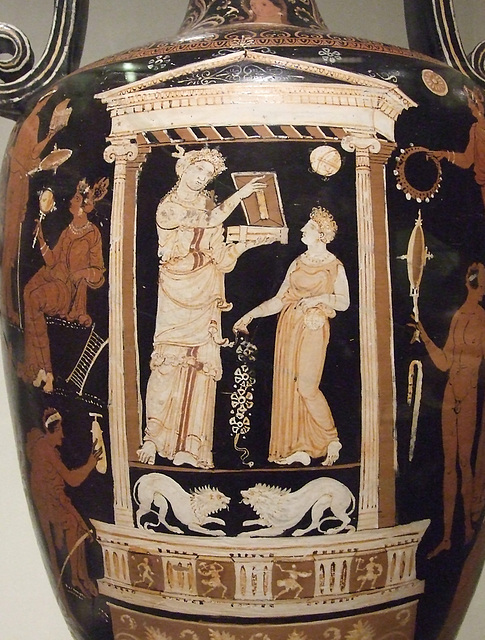Detail of a Terracotta Loutrophoros Attributed to…
Detail of a Terracotta Loutrophoros Attributed to…
Terracotta Stamnos Attributed to the Altamura Pain…
Terracotta Kylix Attributed to a Painter in the Th…
Detail of a Terracotta Kylix Attributed to a Paint…
Terracotta Kylix: Band Cup in the Metropolitan Mu…
Black-Figure Terracotta Hydria: Kalpis in the Metr…
Detail of a Black-Figure Terracotta Hydria: Kalpis…
Terracotta Bell-Krater Attributed to Polion in the…
Detail of a Terracotta Bell-Krater Attributed to P…
Terracotta Pelike Attributed to the Meidias Painte…
Detail of a Terracotta Pelike Attributed to the Me…
Terracotta Oinochoe Attributed to the Mannheim Pai…
Detail of a Terracotta Oinochoe Attributed to the…
Detail of a Terracotta Oinochoe Attributed to the…
Detail of a Terracotta Oinochoe Attributed to the…
Terracotta Bell Krater Attributed to the Painter o…
Detail of a Terracotta Bell Krater Attributed to t…
Detail of a Terracotta Bell Krater Attributed to t…
Terracotta Amphora Attributed to the Gallatin Pain…
Detail of a Terracotta Amphora Attributed to the G…
Terracotta Neck-Amphora Attributed to the Ptoon Pa…
Detail of a Terracotta Neck-Amphora Attributed to…
Terracotta Loutrophoros Attributed to the Metope P…
Detail of a Terracotta Bell-Krater Attributed to t…
Detail of a Terracotta Bell-Krater Attributed to t…
Terracotta Bell-Krater Attributed to the Danae Pai…
Detail of a Terracotta Hadra Hydria in the Metropo…
Terracotta Hadra Hydria in the Metropolitan Museum…
Detail of a White-Ground Terracotta Lekythos in th…
White-Ground Terracotta Lekythos in the Metropolit…
Detail of a Terracotta Neck Amphora Attributed to…
Terracotta Neck Amphora Attributed to a Painter of…
Detail of a Terracotta Column-Krater Attributed to…
Detail of a Terracotta Column-Krater Attributed to…
Terracotta Column-Krater Attributed to the Orchard…
Detail of a Terracotta Kylix, Eye Cup, in the Metr…
Terracotta Kylix, Eye Cup, in the Metropolitan Mus…
Rhodian Terracotta Oinochoe in the Metropolitan Mu…
Terracotta Askos in the Metropolitan Museum of Art…
Detail of a Terracotta Pelike Attributed to the Ma…
Detail of a Terracotta Pelike Attributed to the Ma…
Detail of a Terracotta Pelike Attributed to the Ma…
Detail of a Terracotta Pelike Attributed to the Ma…
Terracotta Pelike Attributed to the Manner of the…
See also...
Keywords
Authorizations, license
-
Visible by: Everyone -
All rights reserved
-
563 visits
Detail of a Terracotta Loutrophoros Attributed to the Metope Painter in the Metropolitan Museum of Art, April 2011


Terracotta loutrophoros (ceremonial vase for water)
Attributed to the Metope Painter
Period: Late Classical
Date: 3rd quarter of the 4th century B.C.
Culture: Greek, South Italian, Apulian
Medium: Terracotta; red-figure
Classification: Vases
Credit Line: Purchase, The Bernard and Audrey Aronson Charitable Trust Gift, in memory of her beloved husband, Bernard Aronson, 1995
Accession Number: 1995.45.1
Description:
On the body, obverse, woman with attendant in naiskos (shrine) flanked by youth and women
Reverse, woman in naiskos flanked by youths and women
On the shoulder, obverse, Eros with alabastron and mirror within foliage
Reverse, head of a woman within foliage
This imposing and beautifully executed vase, together with its counterpart exhibited here, is of exceptional interest for the architectural structure on the obverse. A small naiskos, rendered with three columns, encloses a woman, her maid who holds out a small casket, and a metal loutrophoros. Between the level on which they stand and the podium for the shrine are two panels with a pair of confronted lions. The podium itself consists of an upper frieze of triglyphs, alternating with metopes showing Greeks fighting Amazons. The lower element is covered with tendrils enclosing a female head. Although naiskoi are common on Apulian vases, the complexity and elaboration here are unusual. The unresolved question is to what extent the representation reflects actual funerary structures and the limestone reliefs
familiar especially from Tarentum.
Text from: www.metmuseum.org/collection/the-collection-online/search/256207
Attributed to the Metope Painter
Period: Late Classical
Date: 3rd quarter of the 4th century B.C.
Culture: Greek, South Italian, Apulian
Medium: Terracotta; red-figure
Classification: Vases
Credit Line: Purchase, The Bernard and Audrey Aronson Charitable Trust Gift, in memory of her beloved husband, Bernard Aronson, 1995
Accession Number: 1995.45.1
Description:
On the body, obverse, woman with attendant in naiskos (shrine) flanked by youth and women
Reverse, woman in naiskos flanked by youths and women
On the shoulder, obverse, Eros with alabastron and mirror within foliage
Reverse, head of a woman within foliage
This imposing and beautifully executed vase, together with its counterpart exhibited here, is of exceptional interest for the architectural structure on the obverse. A small naiskos, rendered with three columns, encloses a woman, her maid who holds out a small casket, and a metal loutrophoros. Between the level on which they stand and the podium for the shrine are two panels with a pair of confronted lions. The podium itself consists of an upper frieze of triglyphs, alternating with metopes showing Greeks fighting Amazons. The lower element is covered with tendrils enclosing a female head. Although naiskoi are common on Apulian vases, the complexity and elaboration here are unusual. The unresolved question is to what extent the representation reflects actual funerary structures and the limestone reliefs
familiar especially from Tarentum.
Text from: www.metmuseum.org/collection/the-collection-online/search/256207
- Keyboard shortcuts:
Jump to top
RSS feed- Latest comments - Subscribe to the comment feeds of this photo
- ipernity © 2007-2024
- Help & Contact
|
Club news
|
About ipernity
|
History |
ipernity Club & Prices |
Guide of good conduct
Donate | Group guidelines | Privacy policy | Terms of use | Statutes | In memoria -
Facebook
Twitter

Sign-in to write a comment.